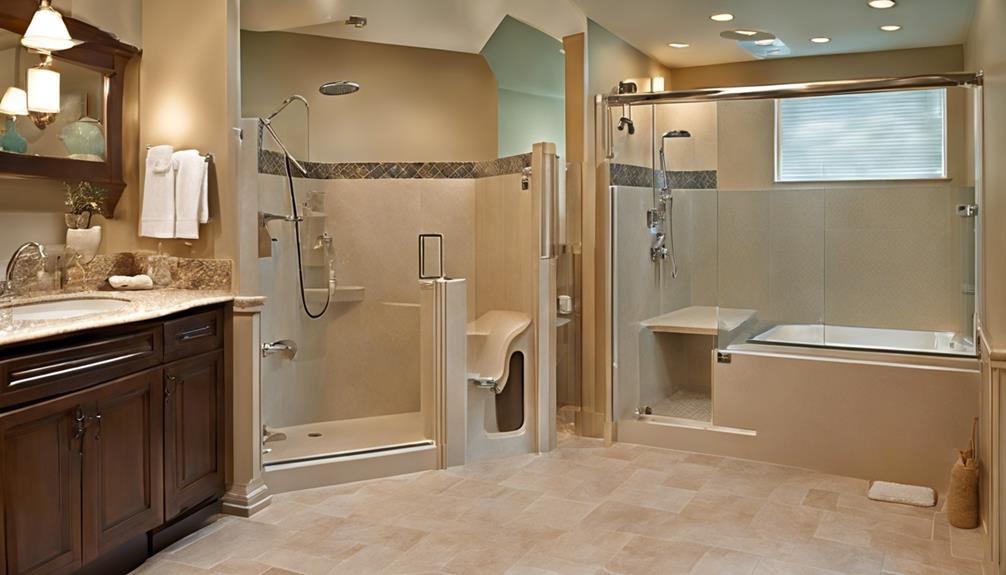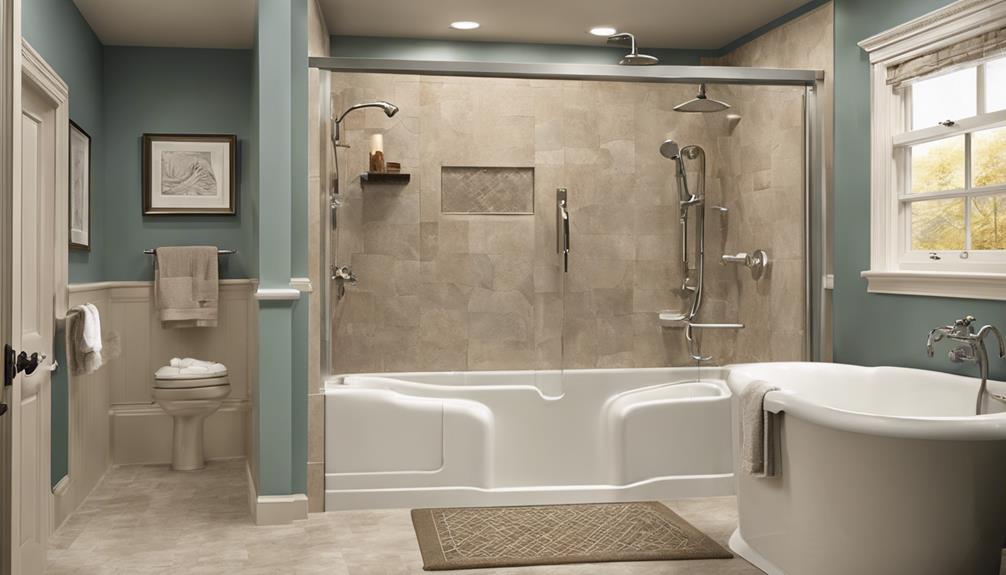When taking care of someone with dementia, it is important to carefully consider the features of walk-in tubs and walk-in showers. Walk-in showers, which come with non-slip flooring and grab bars, are safer as they help prevent falls. They also provide ample space for movement and quick drainage. With immediate water flow and temperature control, they can help minimize frustration. These showers are user-friendly and promote independence. Regular cleaning is necessary for proper hygiene. When deciding between the two options, safety, comfort, and ease of use should be taken into account. Both choices have their advantages, so it is important to choose wisely to ensure the best bathing experience for dementia care. Learning more about the pros and cons of each option will assist you in making an informed decision.
Key Takeaways
- Walk-in showers reduce fall risks with non-slip flooring and grab bars.
- Immediate water access minimizes confusion and promotes independence.
- Quick temperature adjustments ensure safety and comfort during bathing.
- Walk-in showers are easier to use and maintain than walk-in tubs.
- Regular cleaning routines are vital for hygiene in walk-in showers.
Safety Considerations for Dementia Patients
When evaluating safety considerations for dementia patients, opting for a walk-in shower over a walk-in tub may greatly reduce the risk of falls and enhance overall bathing experience. Unlike walk-in tubs that require filling with water before use, walk-in showers provide instant access to water, minimizing confusion and agitation for dementia patients.
The simplicity of walk-in showers allows patients to maintain independence in their bathing routine, promoting a sense of familiarity and comfort. Additionally, walk-in showers equipped with non-slip flooring and grab bars offer a secure bathing environment, further reducing the risk of accidents.
Caregivers can assist patients more effectively in walk-in showers, ensuring their safety and comfort during bathing activities. Overall, the ease of access and safety features of walk-in showers make them a practical choice for dementia patients, enhancing their bathing experience while prioritizing their well-being.
Comfort and Accessibility Features

Considering the need for both comfort and accessibility, walk-in showers stand out as an ideal choice for individuals with dementia. These showers offer more space for easy movement, making it simpler for caregivers to assist during bathing.
The inclusion of grab bars and non-slip flooring in walk-in showers enhances safety and accessibility, providing extra support for dementia patients. Quick drainage in these showers reduces waiting time, promoting comfort and reducing potential discomfort during bathing sessions.
Additionally, seating options in walk-in showers offer added convenience for both the individual with dementia and their caregiver. The safety features inherent in walk-in showers make them a preferable choice for individuals with mobility issues, including those with dementia.
Water Flow and Temperature Control
Walk-in showers provide immediate control over water flow and temperature, offering enhanced comfort and convenience for individuals with dementia. For those in memory care, the ability to adjust the water flow and temperature promptly is essential. Walk-in showers allow for quick temperature adjustments, ensuring a safe and comfortable bathing experience.
This immediate access to water not only reduces confusion but also minimizes frustration during bathing routines. In contrast, walk-in tubs may present challenges for dementia patients to regulate water flow and temperature independently. The ease of controlling water flow in showers, compared to the time it takes for a tub to fill, is particularly beneficial for individuals who may struggle with waiting.
Consistent water temperature in walk-in showers further contributes to a soothing and predictable bathing environment for seniors with dementia. When considering the best bathing option for dementia care, the water flow control and temperature adjustment features of walk-in showers make them a practical choice.
Ease of Use and Maintenance

Opting for a walk-in shower over a walk-in tub greatly enhances ease of use and maintenance for individuals with dementia. Walk-in showers are designed for simplicity, providing easy entry and immediate access to water, which is essential for those with cognitive impairments.
Maintenance for walk-in showers is minimal compared to walk-in tubs, reducing the need for constant upkeep and repairs. The user-friendly nature of walk-in showers makes them ideal for individuals with dementia, as the straightforward design requires less supervision during use, promoting independence.
Additionally, the lower risk of accidents and water-related issues in walk-in showers enhances safety for those with dementia. By opting for a walk-in shower, caregivers can provide a safe and convenient bathing solution that not only prioritizes the individual's independence but also reduces the burden of maintenance, ensuring a more seamless caregiving experience.
Hygiene and Cleaning Concerns
When it comes to hygiene and cleaning concerns in dementia care, we need to contemplate the challenges of cleaning a walk-in tub compared to the maintenance routines of a walk-in shower.
Tub cleaning can be more demanding due to the interior surfaces and intricate design, requiring additional effort to guarantee cleanliness.
On the other hand, showers offer easier access for regular cleaning routines, promoting better hygiene practices for individuals with dementia.
Tub Cleaning Challenges
Thoroughly cleaning a walk-in tub designed for dementia care poses significant challenges due to its intricate structure and hard-to-reach areas, necessitating careful attention to hygiene and maintenance.
The nooks and crannies of walk-in baths can harbor residue and bacteria, raising hygiene concerns. To combat this, regular cleaning routines are vital to prevent contamination and infections.
The complex design of walk-in tubs demands meticulous maintenance to guarantee a safe and sanitary bathing environment for individuals with dementia. By incorporating thorough cleaning practices into the care routine, we can address hygiene issues effectively and maintain a clean, healthy bathing space.
Prioritizing cleanliness and maintenance in walk-in tubs for dementia care is essential for promoting the well-being and comfort of those we serve.
Shower Maintenance Routines
To maintain ideal hygiene and cleanliness in walk-in showers for dementia care, regular cleaning and disinfection are essential to prevent mold and mildew buildup, which can pose risks to seniors with cognitive impairments. In a small bathroom setting, it's vital to pay attention to all areas, including grab rails and the shower head.
Creating a clear policy for shower maintenance routines guarantees that these tasks are consistently carried out. By incorporating regular checks of non-slip mats and grab bars, we can enhance safety for individuals with dementia.
Adequate ventilation is key in preventing moisture accumulation, which can lead to bacterial growth and odors in dementia care settings. Implementing these practices can promote a comfortable and hygienic environment for seniors with dementia in walk-in showers.
Cost and Installation Factors

Affordability stands as a pivotal factor when comparing the cost and installation aspects of walk-in tubs versus walk-in showers for dementia care facilities. Walk-in showers are a cost-effective option for dementia care facilities due to their lower installation and maintenance costs compared to walk-in tubs.
The installation of walk-in tubs can be expensive, especially with additional features like therapy options, potentially straining the budget of these facilities. In contrast, walk-in showers may require minimal electrical work and water heater upgrades, reducing installation costs.
Additionally, walk-in tubs often demand more maintenance and upgrades over time, adding to the long-term expenses of dementia care facilities. Considering the financial constraints faced by these facilities, opting for walk-in showers can be a practical choice to accommodate residents with dementia effectively.
Frequently Asked Questions
Why Won T Dementia Patients Take Showers Anymore?
We comprehend why dementia patients may avoid showers, as sensory sensitivities, fear of falling, memory loss, and environmental triggers contribute to their shower aversion. Providing compassionate support is crucial to help them feel comfortable and safe.
Is a Shower or Bathtub Better for Elderly?
For the elderly, showers are generally better than bathtubs. They offer quicker bathing options, reducing stress for dementia patients. Showers are safer and easier to access, providing flexibility for caregivers. They promote independence and comfort.
What Are the Disadvantages of a Walk-In Tub for Seniors?
Waiting for a walk-in tub to fill and empty can be inconvenient. Some tubs lack proper temperature control, posing scalding risks. Users must remain seated, affecting comfort and safety. Cost can be high, potentially unaffordable.
Should I Get a Walk-In Tub or Shower?
We always consider the individual's needs and preferences when recommending a bathroom upgrade. Both walk-in tubs and showers have their benefits, but in dementia care, the accessibility and safety features of walk-in showers often make them the preferred choice.
Can Walk-In Tub or Walk-In Shower Help with Managing Symptoms of Lewy Body Dementia?
Managing symptoms of Lewy Body Dementia can be challenging, but installing a walk-in tub or walk-in shower can greatly help. The physical symptoms, one of the causes of Lewy Body Dementia, can make bathing difficult, but these accessible options can provide a safer and more comfortable bathing experience.
Conclusion
To sum up, when choosing between a walk-in tub and a walk-in shower for dementia care, it's crucial to take into account safety, accessibility, ease of use, and maintenance.
While a walk-in tub may offer a relaxing and immersive experience, a walk-in shower provides more practicality and ease of cleaning.
Ultimately, the decision hinges on the individual's needs and preferences. Evaluate all factors thoughtfully to establish a comfortable and secure bathing environment for those with dementia.









